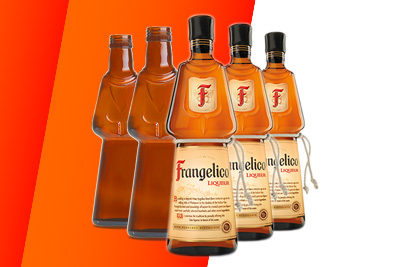Reject before infeed!
Winter bottles? Who already thinks about that in the middle of summer? But they can appear at any time in the reusable sector. Our infeed check module, which detects faulty empty containers already before the actual in-line inspection and reliably removes them from the production flow, is therefore highly recommended. Thanks to brightness compensation, it also increases the quality of the all-surface inspection of empty bottles made of green or amber glass in advance – and effectively protects against unnecessary mass rejections.
From the ice bucket to the sauna. This must be the feeling of a returnable bottle that has been stored outdoors in sub-zero temperatures, and then goes straight into the washing machine at 80 to 90 degrees Celsius. Fortunately, glass drinks containers have no feelings at all. Nevertheless, they suffer in such cases. Namely under thermal stress! For the circular economy in the beverage sector, such winter bottles are thus a real risk factor. Liquid product residues can freeze in them and put the container glass under massive pressure. Temperature differences of up to 100 degrees subsequently create additional stress during washing.
Leaks and chips in the bottle are the result. But also fine cracks in the glass, which can later cause glass breakage in the bottling line and dangerous contamination from flying glass splinters – a serious threat to the production safety and productivity of entire returnable filling plants! At the latest during the all-surface empty bottle inspection with modular HEUFT InLine II systems, affected containers are reliably identified and rejected. However, to avoid lengthy line stoppages, efficiency losses and production downtime, it is better to recognise winter bottles in advance and remove them from the production flow.

Detect winter bottles before they infeed
For this purpose, all of our new generation empty bottle inspectors are available with an upstream infeed check module that detects and rejects the majority of unfit beverage containers before they reach the actual bottling line and cause unnecessary delays: Either they are returned to the bottle washer for re-cleaning or they end up in the waste glass garbage can for good. This applies to winter bottles affected by chipping or cracks as well as to reusable containers that do not match the current production in terms of shape and color.
The visual examination during the infeed check covers a good 270 degrees of the volume of each individual container. And increases the detection and rejection reliability of the subsequent gapless empty bottle inspection in advance – for example with the help of special brightness compensation for beverage containers made of green or amber glass, which effectively protects against production losses due to excessive rejection rates:

Measure colour brightness before empty bottle inspection begins
It is not only winter bottles that contribute to a mixed reusable pool, but also beverage packaging made of new glass, which has to be added again and again and come from different glass manufacturers. Even containers of the same type and format often differ in terms of the brightness of their colouration. To ensure that such harmless deviations do not lead to the unnecessary mass rejection of bottles with no defects each time, their respective brightness is measured and classified in the infeed check.
These differences are subsequently accepted within specified tolerances: The empty bottle inspector then does not subsequently regard differences in brightness as faults. Instead, it optimally adjusts the LED lighting so that the same detection reliability is always guaranteed for each individual bottle. This is made possible by the container tracking with millimetre precision which inspection systems based on the HEUFT SPECTRUM II offer as standard: The HEUFT InLine II for all-surface empty bottle inspection receives the information about the individual brightness of the bottle currently to be inspected in good time so that it can always adjust to it precisely.

Check returnable bottles before product safety and productivity suffer
Bottlers of returnables who decide in favour of such a HEUFT infeed check module therefore need not be afraid of winter bottles which have been subjected to thermal stress any more than they need be afraid of bottles of different brightness in coloured glass:
The former are detected and removed from circulation before the actual empty bottle inspection, while the latter are tolerated and – classified into the correct brightness class – passed on to the empty bottle inspector. This ensures full inspection quality as well as effective protection against unwanted losses in productivity due to unnecessary mass rejections.










